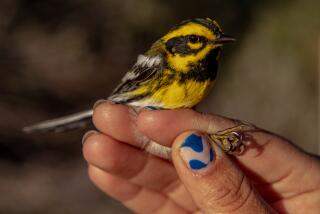Hummer’s Heaven : Endangered Birds Get First-Class Treatment in the Care of a Licensed Bander in Missouri
- Share via
SPRINGFIELD, Mo. — Bill Coughenour’s breed is rarer than the Bachman sparrow, a tiny Ozarks songbird on the endangered species list.
Coughenour bands hummingbirds--ruby-throated hummingbirds, to be exact.
Only 31 people are fully licensed by the federal government to put numbered metal bands on the legs of the tiny aerial acrobats. Coughenour is among a few who have limited permits to work under supervision of the “master” banders.
“I’ve banded about 350 hummingbirds in the three years I’ve been licensed. I might end up banding 250 to 300 this year,” said Coughenour, 41, who learned to band from his great-uncle, Jim Johnson, the only master in the state.
Johnson, 85, of Holister, Mo., has banded about 2,000 hummingbirds over the last 20 years, earning him the nickname “The Hummingbird Man.” Coughenour’s sister, Sarah Driver of Springfield, also bands under his direction.
Quest for Information
“There’s millions of hummingbirds out there, and there’s just not enough of us banding,” said Coughenour. “The whole reason for banding is to get information about birds and their habits, particularly migration.”
Coughenour, a businessman who bands birds as a hobby, uses a homemade nylon net trap, with a feeder filled with sugar water as bait, to catch the “hummers” at his home in Nixa and at the Springfield Nature Center.
He then carefully weighs the birds--most weigh about 3 grams, the equivalent of three plastic sandwich bags--and notes the sex, approximate age and general condition. The whole process takes just a few minutes.
Seventeen species of hummingbirds are found in the United States, but only the ruby-throated variety is common east of the Great Plains.
Hummingbirds are attracted to almost any plant with red blossoms and are easily drawn to feeders filled with one part sugar to four parts water. Johnson said the ruby-throats, named for the male’s brilliant red throat patch, consume up to a gallon of sugar water a day at 10 feeders around his home each summer.
Need for Energy
The long-billed birds have a voracious appetite for sweet nectar to fuel their supercharged metabolism. Hummingbirds’ wings beat an astounding 50 to 70 times a second as they hover and feed, but speed up to 200 beats per second when they need to zip away at up to 60 m.p.h.
Hummingbirds migrate long distances, including a 600-mile trip non-stop across the Gulf of Mexico to spend the winter in South and Central America. The birds can live five to eight years and return each year to the same territory.
“I have found them to be just such friendly little rascals. They are so curious,” Johnson said. “They have some kind of personal reaction to humans. It’s hard to describe, but once you get to fooling with them, you realize they are very responsive birds. You can really get to know them individually.”
Making friends with a hummingbird is “no trouble at all. All you need is sugar water to get their attention, he said.”
“I have a standing bet with people that if they have one to three hummingbirds at a feeder, I can have one perching on my finger in 20 minutes. If you get near the feeder and remain motionless, they’ll perch right on your finger as they feed. It’s the darndest thing.”
Coughenour, who gives talks and banding exhibitions each summer at the Springfield Nature Center, said, “Many of the older people remember a time when everyone had formal flower gardens and people would sit outside in the summertime and really enjoy the hummingbirds.
“Some people my age have never seen a hummingbird. When they do, they’re fascinated. It’s a real joy, particularly with little kids, to see the delight in their eyes when showing them such a small, fragile creature.
“They are very, very beautiful to look at.”
More to Read
Sign up for Essential California
The most important California stories and recommendations in your inbox every morning.
You may occasionally receive promotional content from the Los Angeles Times.










